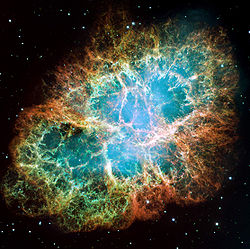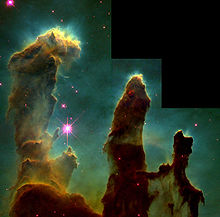- Nebulae in fiction
-
Nebulae, often being visually interesting astronomical objects, are frequently used as settings or backdrops for works of science fiction.
Contents
Crab Nebula
- Earthmen meet an alien race for the first time within the Crab Nebula in the science fiction story First Contact (Astounding, May 1945) by Murray Leinster.
- In the Doctor Who serial, Colony in Space, the Master reveals that the Crab Nebula's creation was the result of the Super Race of the planet Exarius (or Uxarius) testing their Doomsday Weapon, a device which could project anti-matter at super-luminal speed.
- In Battle of the Planets (the Americanized version of the Japanese television program, Gatchaman), the Crab Nebula is the home of the planet Spectra[citation needed], from which Zoltar and the Great Spirit are engaged in a war to defeat the Federation (a group of planets that includes Earth).
- In the Roleplaying video game Mass Effect, the Crab Nebula can be traveled to, although in the game it has been renamed to the Hades Gamma Cluster.
- In the movie Dude, Where's my Car?, two Nordic aliens tell Chester and Jesse that they are having a party at the Crab Nebula.
- In the Game "Freespace 2", the Crab Nebula is one of the two potential real-world candidates for the game's Nebula system, the other being the Lupus Nebula (NGC 5882).
- In The Return of Ultraman, the energy absorbing monster, Bemstar, came from Crab Head Nebula.
- In Colossus and the Crab, a novel by Dennis Feltham Jones and the final volume of The Colossus Series, intelligent and powerful Martians prepare for the day when deadly radiation from the Crab Nebula will reach Earth and Mars.
- In Psion, a novel by Joan D. Vinge, a planetoid in the Crab Nebula is an important source of a highly radioactive substance essential to faster-than-light navigation.
Eagle Nebula
- The accompanying Hubble image is one of the most popular poster images of outer space, and often appears in science-fiction movies. The Eagle Nebula was one of the space regions passed through during the opening "zoom out" shot of the movie Contact (1997), and appeared in the opening scene of the Babylon 5 episode "Into the Fire". The Eagle Nebula, along with the Hourglass Nebula, was featured in the liner notes of Pearl Jam's 2000 album Binaural.
- The PC Game Freelancer supposedly takes place in and around the Eagle Nebula[citation needed]
- The Pillars of Creation shot of the nebula can also be seen displayed on the monitors of the astrometrics labs of some episodes of the show Star Trek Voyager.
- The Eagle Nebula appears in the video game Mass Effect 2. One mission to recruit a squadmate and two optional side missions take place within the nebula.
Horsehead Nebula
- The main character from the animated TV series Widget hails from the Horsehead Nebula.
- In The Hitchhiker's Guide to the Galaxy, the Horsehead Nebula is transit point en route to Earth, and the location of Magrathea.
- In the 1978 Captain Harlock series, Harlock is led to believe a Mazone base is located within the Horsehead Nebula.
- Isaac Asimov's novel The Stars, Like Dust involves a search for a rebellion world, which the characters supposed to be located in the nebula. Asimov exemplifies the geocentrism of the nebula's name by having one character expound the false etymology that the nebula (which, from most other vantage points, looks nothing like a horse's profile) is named for a pioneer explorer named Horace Hedd.
- The novel The Ship Who Sang by Anne McCaffery repeatedly mentions the idea of "making a run for the Horsehead Nebula," apparently as something extremely difficult or awe-inspiring.
- In the video game The Orion Conspiracy, the entire Horsehead Nebula is sucked into a black hole that apparently appears out of nowhere. This freak formation of a black hole is in the game dubbed the Orion Effect.
- In the Ship series, traveling the Horsehead Nebula is commonly referenced as the ultimate achievement for a Brainship team.
- In the Doctor Who episodes "The Impossible Planet","The Satan Pit" and "Planet of the Ood", the Ood's homeworld, the Ood-Sphere, is situated in the Horsehead Nebula.
- In the video game Mass Effect, the Horsehead Nebula is a navigable cluster, containing the Strenuus system (which houses the planets Yunthorl, Antitarra, Trelyn, Xawin, Thesalgon, and the orbiting MSV Majesty), the Pax system (which hosts the planets Svarog, Noveria, Morana, and Veles), and the Fortuna system (which houses the planets Maganlis, Amaranthine, Therumlon, and Wentania).
- In the Malo Korrigan episode "Old Soldier", the Horsehead Nebula is the setting for a mechanical failure in the Starduke's engine.
- In South Park Ursula The Giant Douche (one of the BDIU nominees) is from the Horsehead Nebula (Station J-12.) Willzyx The Zypod also claims he is being held prisoner by communists from the Horsehead Nebula.
- In The 13½ Lives of Captain Bluebear by Walter Moers it is explained that when in multidimensional space, you are everywhere in the world at once - not only on earth, but also "on the moon and on Saturn, in the Horsehead Nebula and on Cassiopia's starry throne, ... and everywhere else in the known universe".
- In the Northern Exposure episode "Our Tribe", Holling Vincoeur tells Maggie about a star he's looking for in the Horsehead Nebula which he "purchased" in honor of an old friend.
- In the Black Stallion series children's novel "The Young Black Stallion", The Black's owner, Alec Ramsey contemplates the Horsehead Nebula and the tantalizing theory that his horse was sired by a celestial equine.
- In the 2008 Disney/Pixar animated film WALL-E, the Axiom is situated near to the Horsehead Nebula.
Hourglass Nebula
- The Hourglass Nebula appears on the cover of Pearl Jam's 2000 album Binaural.
- The Hourglass Nebula features prominently in the plot of the OVA Captain Herlock: The Endless Odyssey.
- The Hourglass Nebula appears in the game Final Doom
- The Hourglass Nebula appears on a poster in the CERN laboratory in the film Angels & Demons
- The Hourglass Nebula appears in the game Mass Effect 2 as one of the clusters that can be visited for missions.
IC 2118
- In the TV show Andromeda, the Witch Head Nebula (IC 2118) was the site of the last major stand between the Old Commonwealth and the Nietzschean Alliance. Nietzscheans tell a story of how the Angel of Death appears in the sky, and lit up the cosmos with fire. This effectively crushed both the remainder of the Old Commonwealth fleet, as well as crippled a good majority of the Nietzschean fleet - leaving the way for disorder and instability.
Lagoon Nebula
- Object M8: In the science fiction TV show Battlestar Galactica, the Lagoon Nebula is seen in the episode "Home, Part II", in the Tomb of Athena on Kobol and along with the presence of the twelve zodiac symbols, it serves as a rough reference point to the location of Earth. Since the nebula looks the same from Earth and from the Twelve Colonies, the two star systems lie in a relatively straight line with the nebula. The nebula was erroneously stated to be in the constellation Scorpio in the episode; a mistake acknowledged by the producers. William Adama refers to the Nebula as "M8", its Messier catalog number.
- In the movie Treasure Planet, the main characters open a portal to distant regions of space. The first one is said to be the Lagoon Nebula, and it is also said to be "halfway across the galaxy."
- In the video game Mass Effect, the Lagoon Nebula is one of the places the player may travel to.
Messier 78
- M78 is the location of the Land of Light (Planet), the homeplanet of Ultraman, Ultra Seven, Ultraman Mebius and many other M78 Ultra heroes of the Ultra Series.
- M78 is also the location of the home of Nadia in Nadia: The Secret of Blue Water.
Omega Nebula
- Parts of the video game Mass Effect 2 take place in the Omega Nebula.
Orion Nebula
- The Orion Nebula is the special stage in the computer game "Mark Galaxy". In which the main character, Mark, flies around the nebula collecting coins
- In the movie The Fountain, the Orion nebula is referred to as Xibalba and is featured prominently throughout the movie as a symbol of death and rebirth.[citation needed]
- In The Naked God by Peter F. Hamilton, Syrinx and Joshua fly to the other side of the Orion Nebula to try to find more information about the whereabouts of the sleeping god.
- The events of Andrey Livadny's novel The Orion Nebula take place almost entirely in a star system inside the Orion Nebula. It is also found to be the location of one of many instances of a being which is responsible for the creation of all organic life in the universe (which was an accident).
- In the Aliens vs. Predator game for the Super NES, the Orion nebula is where the Xenomorph homeworld is located.
- In the English dub of Star Blazers: The Bolar Wars (Space Battleship Yamato III), Earth and its Solar System are erroneously said to be located in the Orion Nebula.
Trifid Nebula
- The Trifid Nebula is frequently seen in Beast Wars in space scenes throughout the series.
It is also seen in the Star Trek Original series episode "The Alternative Factor"
Veil Nebula
- The Veil Nebula was the site of the last "unstable planet" visited by the spaceship Dark Star in the film of the same name.
Astronomical locations in fiction Solar System Mercury • Venus • Earth (Moon) • Mars (moons) • Ceres (other asteroids) • Jupiter (moons) • Saturn (Titan • other moons) • Uranus • Neptune • Pluto (other TNOs • comets) • Fictional planets

Other systems Aldebaran • Alpha Centauri • Altair • Betelgeuse • Deneb • Epsilon Eridani • Rigel • Sirius • Tau Ceti • Vega • Binary stars • Nebulae • Black holes • Galaxies • Supernovae • Wormholes
Categories:- Astronomical locations in fiction
- Nebulae
Wikimedia Foundation. 2010.


